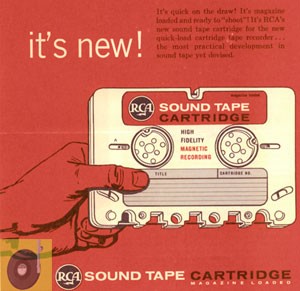The second outcome of the use of multitrack recordings was the most evident to the consumer; the advent of stereo sound. Engineers in the 1930s had discovered that a two-channel (or more) recording, utilizing two microphones, two amplifiers, and two loudspeakers, gave aurally pleasing results. The “stereo effect” as it was called was often described as “realistic,” because human hearing has the capacity to identify the location of a sound source based on the slight time delay in the reception of sound in each ear. In the 1950s, engineers found that the stereo effect is false-the original location of the instruments in the studio is not perfectly simulated when a stereo recording is reproduced. However, most listeners prefer the three-dimensionality of the stereo effect, and it proved to be very popular. However, it required that consumers, like studio engineers, purchase equipment that could play stereo records, along with two-channel amplifiers and a second loudspeaker.

RCA stereo tape cartridge, introduced in 1957
The first stereo recordings available to the public were in the form of reel-to-reel tape. Recorder manufacturers offered add-on stereo tape heads and off board amplifiers that could be added to existing recorders. Stereo recorders with a second head mounted next to the main head soon appeared. Almost simultaneously, tape recorders with two miniaturized, stacked heads mounted in the same housing appeared; tapes for these recorders were incompatible with the earlier “staggered” head recorders. Then in 1957-8 RCA introduced a recorder with a super-compact tape head that stacked four heads in the place of just two, allowing a stereo tape to be flipped over and played on both sides like a mono tape. These large “four track” tape cartridges could not be played on either of the other two stereo systems. This lack of compatibility, combined with the high price of stereo tapes, discouraged sales. Meanwhile, another division of RCA introduced the stereo LP record, also in 1957-8, along with moderately priced stereo phonographs (stereo 45-rpm discs soon followed). Stereo LPs could not be played on monophonic players, so for many years mono and stereo versions of the same recordings were available. During the 1960s, most record companies discontinued mono LPs.